A) increase the size of its store and parking lot only if Lopes also increases the size of its store and parking lot.
B) increase the size of its store and parking lot only if Lopes does not increase the size of its store and parking lot.
C) increase the size of its store and parking lot regardless of the decision made by Lopes.
D) not increase the size of its store and parking lot regardless of the decision made by Lopes.
F) B) and C)
Correct Answer

verified
Correct Answer
verified
Multiple Choice
Table 17-7
The information in the table below shows the total demand for internet radio subscriptions in a small urban market. Assume that each company that provides these subscriptions incurs an annual fixed cost of $20,000 (per year) and that the marginal cost of providing an additional subscription is always $16. 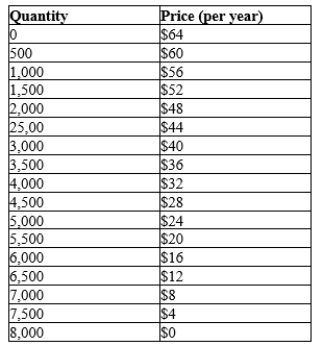 -Refer to Table 17-7. Suppose there is only one internet radio provider in this market and it seeks to maximize its profit. The company will
-Refer to Table 17-7. Suppose there is only one internet radio provider in this market and it seeks to maximize its profit. The company will
A) sell 2,000 subscriptions and charge a price of $48 for each subscription.
B) sell 3,000 subscriptions and charge a price of $40 for each subscription.
C) sell 4,000 subscriptions and charge a price of $32 for each subscription.
D) sell 5,000 subscriptions and charge a price of $24 for each subscription.
F) B) and C)
Correct Answer

verified
Correct Answer
verified
Multiple Choice
The Sherman Antitrust Act was passed in
A) 1836.
B) 1890.
C) 1914.
D) 1946.
F) A) and B)
Correct Answer

verified
Correct Answer
verified
Multiple Choice
Figure 17-4. Aaron and Ed are roommates. After a big snowstorm, their driveway needs to be shoveled. Each person has to decide whether to take part in shoveling the driveway. At the end of the day, either the driveway will be shoveled (if one or both roommates take part in shoveling) , or it will remain unshoveled (if neither roommate shovels) . With happiness measured on a scale of 1 (very unhappy) to 10 (very happy) , the possible outcomes are as follows: 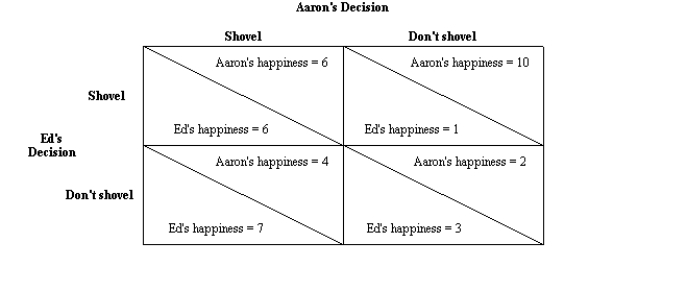 -Refer to Figure 17-4. If this game is played only once, then which of the following outcomes is the most likely one?
-Refer to Figure 17-4. If this game is played only once, then which of the following outcomes is the most likely one?
A) Aaron and Ed both shovel.
B) Aaron shovels and Ed does not shovel.
C) Ed shovels and Aaron does not shovel.
D) All of the above outcomes are equally likely.
F) None of the above
Correct Answer

verified
Correct Answer
verified
Short Answer
Scenario 17-6 Assume that a local telecommunications company sells high speed internet access and cable television. The company's only two customers are Taylor and Tim. Taylor is willing to pay $50 per month for high speed internet access and $50 per month for cable television. Tim is willing to pay only $20 per month for high speed internet access, but is willing to pay $70 per month for cable television. Assume that the telecommunications company can provide each of these products at zero marginal cost. -Refer to Scenario 17-6. If the telecommunications provider is able to use tying to price high speed internet access and cable television, what is the profit-maximizing price to charge for the "tied" good?
Correct Answer

verified
Correct Answer
verified
Multiple Choice
Table 17-6
Imagine a small town in which only two residents, Kunal and Naj, own wells that produce safe drinking water. Each week Kunal and Naj work together to decide how many gallons of water to pump, to bring the water to town, and to sell it at whatever price the market will bear. Assume Kunal and Naj can pump as much water as they want without cost so that the marginal cost of water equals zero.
The weekly town demand schedule and total revenue schedule for water are shown in the table below. 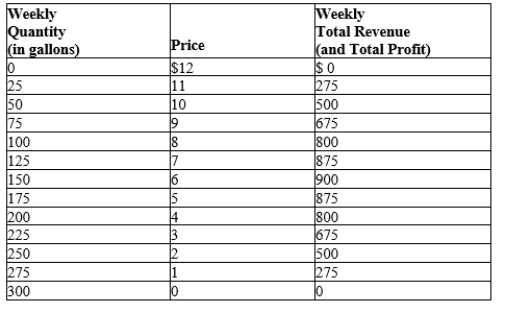 -Refer to Table 17-6. Since Kunal and Naj operate as a profit-maximizing monopoly in the market for water, what price will they charge for water?
-Refer to Table 17-6. Since Kunal and Naj operate as a profit-maximizing monopoly in the market for water, what price will they charge for water?
A) $2
B) $4
C) $6
D) $7
F) A) and D)
Correct Answer

verified
Correct Answer
verified
Multiple Choice
Two suspected drug dealers are stopped by the highway patrol for speeding. The officer searches the car and finds a small bag of marijuana and arrests the two. During the interrogation, each is separately offered the following: "If you confess to dealing drugs and testify against your partner, you will be given immunity and released while your partner will get 10 years in prison. If you both confess, you will each get 5 years." If neither confesses, there is no evidence of drug dealing, and the most they could get is one year each for possession of marijuana. If each suspected drug dealer follows a dominant strategy, what should he/she do?
A) Confess regardless of the partner's decision
B) Confess only if the partner confesses
C) Don't confess regardless of the partner's decision
D) Don't confess only if the partner doesn't confess
F) B) and D)
Correct Answer

verified
Correct Answer
verified
Multiple Choice
In the prisoners' dilemma game, self-interest leads
A) each prisoner to confess.
B) to a breakdown of any agreement that the prisoners might have made before being questioned.
C) to an outcome that is not particularly good for either prisoner.
D) All of the above are correct.
F) B) and D)
Correct Answer

verified
Correct Answer
verified
Multiple Choice
Which of the following groups or entities has the authority to initiate legal suits to enforce antitrust laws?
A) the U.S. Justice Department
B) private citizens
C) corporations
D) All of the above are correct.
F) B) and D)
Correct Answer

verified
Correct Answer
verified
Multiple Choice
As a group, oligopolists earn the highest profit when they
A) achieve a Nash equilibrium.
B) produce a total quantity of output that falls short of the Nash-equilibrium total quantity.
C) produce a total quantity of output that exceeds the Nash-equilibrium total quantity.
D) charge a price that falls short of the Nash-equilibrium price.
F) B) and C)
Correct Answer

verified
Correct Answer
verified
Multiple Choice
Table 17-26
Two prescription drug manufacturers (Firm A and Firm B) are faced with lawsuits from states to recover the healthcare related expenses associated with side-effects from its drugs. Each drug manufacturer has evidence that indicates that taking its prescription drug causes liver failure. State prosecutors do not have access to the same data used by drug manufacturers and thus will have difficulty recovering full costs without the help of at least one of the drug manufacturer's studies. Each firm has been presented with an opportunity to lower its liability in the suit if it cooperates with attorneys representing the states.  -Refer to Table 17-26. Which of the following statements is correct?
-Refer to Table 17-26. Which of the following statements is correct?
A) Neither firm A nor firm B has a dominant strategy.
B) Both firm A and firm B have a dominant strategy.
C) If this game were repeated, these firms would choose different strategies than they choose in a one-period game.
D) This game is a typical prisoner's dilemma in which the firms are worse off by making decisions in their own self-interest.
F) B) and C)
Correct Answer

verified
Correct Answer
verified
Multiple Choice
Predatory pricing occurs when
A) firms collude to set prices. Economists are certain this practice is profitable.
B) firms collude to set prices. Economists are skeptical that this practice is profitable.
C) A monopolist decreases its prices to maintain its monopoly. Economists are certain this practice is profitable.
D) A monopolist decreases its prices to maintain its monopoly. Economists are skeptical that this practice is profitable.
F) B) and D)
Correct Answer

verified
Correct Answer
verified
Multiple Choice
In markets characterized by oligopoly,
A) the oligopolists earn the highest profit when they cooperate and behave like a monopolist.
B) collusive agreements will always prevail.
C) collective profits are always lower with cartel arrangements than they are without cartel arrangements.
D) pursuit of self-interest by profit-maximizing firms always maximizes collective profits in the market.
F) None of the above
Correct Answer

verified
Correct Answer
verified
Short Answer
Cooperation is easier to achieve in __________.
Correct Answer

verified
Correct Answer
verified
True/False
A dominant strategy exists for at least one player in every game.
B) False
Correct Answer

verified
Correct Answer
verified
Multiple Choice
When individuals are damaged by an illegal arrangement to restrain trade, which law allows them to pursue civil action and recover up to three times the damages sustained?
A) Trade Damage Act
B) Clayton Act
C) Sherman Act
D) No law allows individuals to pursue civil action and recover up to three times the damages sustained.
F) All of the above
Correct Answer

verified
Correct Answer
verified
Multiple Choice
As the number of firms in an oligopoly increases, the
A) price approaches marginal cost, and the quantity approaches the socially efficient level.
B) price and quantity approach the monopoly levels.
C) price effect exceeds the output effect.
D) individual firms' profits increase.
F) A) and C)
Correct Answer

verified
Correct Answer
verified
Multiple Choice
In an oligopoly, the total output produced in the market is
A) higher than the total output that would be produced if the market were a monopoly and higher than the total output that would be produced if the market were perfectly competitive.
B) higher than the total output that would be produced if the market were a monopoly but lower than the total output that would be produced if the market were perfectly competitive.
C) lower than the total output that would be produced if the market were a monopoly but higher than the total output that would be produced if the market were perfectly competitive.
D) lower than the total output that would be produced if the market were a monopoly and lower than the total output that would be produced if the market were perfectly competitive.
F) A) and B)
Correct Answer

verified
Correct Answer
verified
Multiple Choice
Table 17-5
The information in the table below shows the total demand for premium-channel digital cable TV subscriptions in a small urban market. Assume that each digital cable TV operator pays a fixed cost of $200,000 (per year) to provide premium digital channels in the market area and that the marginal cost of providing the premium channel service to a household is zero. 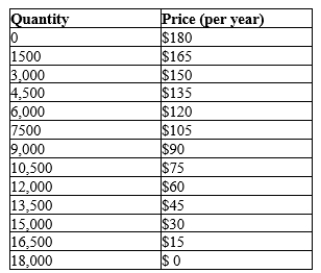 -Refer to Table 17-5. If there is only one digital cable TV company in this market, what price would it charge for a premium digital channel subscription to maximize its profit?
-Refer to Table 17-5. If there is only one digital cable TV company in this market, what price would it charge for a premium digital channel subscription to maximize its profit?
A) $30
B) $60
C) $90
D) $150
F) C) and D)
Correct Answer

verified
Correct Answer
verified
Multiple Choice
Figure 17-5. Two companies, ABC and QRS, are sellers in the same market. Each company decides whether to charge a high price or a low price. In the figure, the dollar amounts are payoffs and they represent annual profits for the two companies. 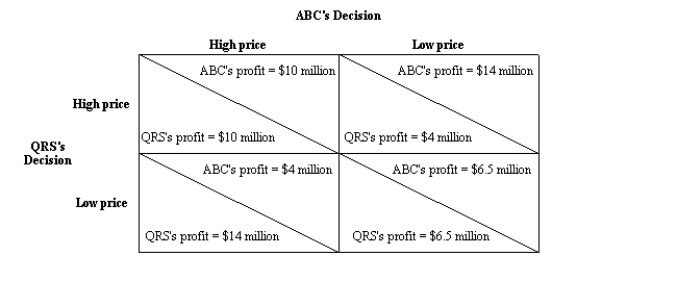 -Refer to Figure 17-5. The dominant strategy for ABC is to
-Refer to Figure 17-5. The dominant strategy for ABC is to
A) charge a high price, and the dominant strategy for QRS is to charge a high price.
B) charge a high price, and the dominant strategy for QRS is to charge a low price.
C) charge a low price, and the dominant strategy for QRS is to charge a high price.
D) charge a low price, and the dominant strategy for QRS is to charge a low price.
F) None of the above
Correct Answer

verified
Correct Answer
verified
Showing 461 - 480 of 522
Related Exams